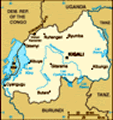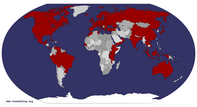Advertisement
Published: August 9th 2013

 View over Lake Kivu
View over Lake Kivu
Lake Kivu is one of three known killer lakes in the worldLake Kivu – Beautiful and Lethal
Rwanda must be one of the must underrated countries in the world. It is a very beautiful country, one of the safest countries in all of Africa, the people of Rwanda are very friendly and it is very easy to travel around. Rwanda also has some spectacular tourist attractions such as gorilla spotting and wildlife safari. Those attractions we have decided to write about in separate blog entries. In this blog entry and the next we will try to show some other sides of Rwanda instead of the mainstream touristy.
Lake Kivu is one destination visitors in Rwanda are likely to end up at. The cities Rubavu, or rather the satellite town Rubona, and Karongi can both be called resort towns. Since Rwanda doesn’t have a great influx of foreign tourists these resorts are much more relaxed than many other similar places we have visited over the years.
Around Lake Kivu we visited three places: Rubavu, Rubona, and Karongi. All three can be labelled resort towns but they are not by any means dominated by tourists or tourist facilities. Most of the people living in these towns

 Fishing boats on Lake Kivu
Fishing boats on Lake Kivu
The fishermen use trimarans as fishing boatslive from fishing, farming or work in the local industries. All three are nice enough places and worth a visit.
In Karongi we went on a boat trip to two islands in Lake Kivu. The first island was the home of a large colony of fruit bats and the other island had a beach, a bar and some accommodation.
In Rubona we visited the local market, where we bought some fruit, we walked along the shores of Lake Kivu and we walked to a small hot spring right outside of town. We tried to go to the local methane extraction facility but were stopped by the military who claimed that we could only go to the plant if we had a special invitation, a claim that most likely was a load of bull but one that we decided not to argue about.
In Rubavu we walked up to the border to Congo mostly for the reason to be able to say that we walked all the way to Congo and back. The border crossing is more of less inside the town and we were out for a walk anyway so why

 View over Lake Kivu
View over Lake Kivu
Limnic eruptions can occur in deep lakes. If carbon dioxide is released into water the gas is dissolved in the water. Large quantities of dissolved gas can be released all at once in a so called limnic eruptionnot go there?
We also visited several other places in Rwanda. When we went on the gorilla tour we stayed in Musanze for a night. There we visited the Musanze Caves, or rather tried to visit. The caves were temporarily closed because they are working on making them more accessible. The guard at the caves told us that we could be "permitted" to enter the cave if we gave him some money or bought him a beer. Bribing people is something we try to avoid if possible so we declined that offer.
By the way, Musanze Caves are not caves at all, they are
lava tubes. Lava tubes are created when lava is expelled by a volcano during an eruption. The lava sometimes finds river beds to flow in. When the lava cools down it it does so from the top down. So at the top it turns solid and creates "a lid" which encloses the hot lava which then is protected from the cool air and can stay hot and liquid. It works much like when water in winter turns to ice on rivers and creates a solid surface above the water underneath. If

 Lake Kivu
Lake Kivu
There have only been two known limnic eruptions both in lakes in Cameroon. But it could happen in Lake Kivuthe eruption suddenly stops and the lava flow stops the lava under “the lid” is still hot and in a liquid state and keeps flowing leaving an empty space under “the lid”. What is left is a lava tube.
When we were driving past the village Rwamagana we stopped and had a look at the church there. Most of the churches in Rwanda we saw were quite small. This one was an exception though.
Rwanda was a monarchy up until 1961 and the royal family lived in the town Nyanza. Today the former royal palace is a museum, a slightly overpriced museum where they also have the nerve to ask for even more money if you want to take photos. The royal palace tour includes the palace that was used up until monarchy was abolished, a replica of some of the houses that served as a palace in early days and a visit to see a certain breed of cows that were only owned by the royal family. Those cows were only used for ceremonial purposes and not for production of meat or milk.
Another slightly overpriced museum, where they also

 Swimmers in Rubavu
Swimmers in Rubavu
Locals swimming at the beach in Rubavuhave the nerve of asking for even more money if you want to take photos, is the former presidential palace outside Kigali. It was used as a palace from 1960-ies up until mid 1990-ies when the president moved to a palace in central Kigali. The president moved to the new palace because the former palace was built near the Kigali Airport. When they in the early 1990-ies changed the flight routes at the airport the presidential palace was right underneath the air corridor leading to the main runway of the airport. The noise from the planes made it impractical to use the building as a presidential palace. Imagine having the US president or the Secretary-General of the UN over for dinner and be forced to hand out earplugs in case a Boeing 747 takes off from the airport while you are eating.
In the southeast corner of Rwanda we saw the Rusumo waterfall, the largest waterfall in Rwanda. The waterfall is located right on the border between Rwanda and Tanzania. To see the waterfall we had to pass the checkpoint on the Rwandan side, leave our passports with a guard and cross the river over to the

 Lake Kivu
Lake Kivu
Limnic eruptions are so rare that the phenomenon was unknown to the scientific world before 1984.Tanzanian side for a good view.
In the headline we stated that Lake Kivu is leathal. That is because Lake Kivu is very different from most lakes – Lake Kivu is one of three known killer lakes in the world. The phenomenon is known as
limnic eruption and is so rare that is was actually unknown to the scientific world before 1984. Limnic eruptions can occur in deep lakes in volcanically active areas. If volcanic vents release carbon dioxide or other gases into water and the water pressure is high enough, such as at the bottom of a deep lake, the gas is dissolved in the water. Think of a carbonated soft drink and you get the idea. When the drink is under pressure, when the lid in on, the gas is dissolved in the liquid. As more and more carbon dioxide is released the water eventually gets saturated. What happens than is that large quantities of dissolved gas can be released all at once in a so called limnic eruption. Again it works pretty good to think of a carbonated soft drink. Take one, shake it for a while and then release the lid and

 Lake Kivu
Lake Kivu
If a limnic eruption ever happens in Lake Kivu it could lead to an enormous disaster.you get something similar.
The gas released from a carbonated soft drink is carbon dioxide. Carbon dioxide in low concentrations we inhale all the time and is totally harmless but if inhaled in high concentrations it render you unconscious in a minute or two and will kill you soon afterwards. In a soft drink the amounts of carbon dioxide are relatively small and when it is released it is mixed with the air and becomes harmless. When a killer lake release carbon dioxide in a limnic eruption the quantities of are very much larger. Carbon dioxide is a relatively heavy gas, a fact that is used in some kinds of fire extinguishers by the way, and when released it tends to push away air. So when a limnic eruption occurs the air over and around the lake is replaced with carbon dioxide, a gas that in high concentrations can kill you within 10 minutes.
There have only been two known limnic eruptions. The first one happened in Lake Monuon in Cameroon in 1984 where 37 people were killed. The second one happened in Lake Nyos, also in Cameroon, in 1986. At that occasion about

 Lake Kivu
Lake Kivu
All three of the known killer lakes are being constantly monitored. So even though we previously labelled Lake Kivu a killer lake the danger involved visiting it is negligible.1200 people died. These were certainly not the first eruptions. But previous such events have not been made known outside the area where it happened and there are no written records about when or where they occurred or the number of fatalities.
After the tragedy in Lake Nyos in 1986, when the phenomenon finally was understood, a study was made to try to locate other lakes where limnic eruptions might happen. Only one more lake was found – Lake Kivu. If a limnic eruption ever happens in Lake Kivu the consequences could be disastrous. The killer lakes in Cameroon are small and not many people live around them. Lake Kivu is more than 1,000 times larger than Lake Nyos, the larger of the two killer lakes in Cameroon, and can consequently hold much larger quantities of carbon dioxide. Around Lake Kivu there live approximately 2 million people. So if Lake Kivu ever has a limnic eruption it could lead to a disaster with between five and ten times more fatalities than one of the largest catastrophes in the last 100 years, the Indian Ocean tsunami in 2004.
All three of the known killer lakes
are being constantly monitored and gas is released through pipes in order to keep the gas levels at the bottom at safe levels. In Lake Kivu there are at least two power plants in operation where they extract gas from the bottom of the lake. The gas in Lake Kivu is not only carbon dioxide but also contains methane. Methane is a flammable gas that you can use as a heat source or to create electric power. So even though we previously labelled Lake Kivu a killer lake the danger involved visiting it is negligible. If you visit the lake you are more likely to die from a heart attack than from a limnic eruption.
When we travelled in Rwanda we were constantly reminded of the Rwandan genocide that took place in 1994. We will publish a separate blog entry on that and some of the places we have mentioned above will we write about again.
Advertisement
Tot: 0.173s; Tpl: 0.015s; cc: 10; qc: 32; dbt: 0.1098s; 1; m:domysql w:travelblog (10.17.0.13); sld: 1;
; mem: 1.2mb



























Shanghai Sheri
Schroeder family
Rwanda questions
Your blog is a great summary of the many parts of Rwanda. I am planning a trip there for next October. Did you use a tour agency? If so, do you have any recommendations for reliable, honest tour guide/transportation/accommodation organizer?